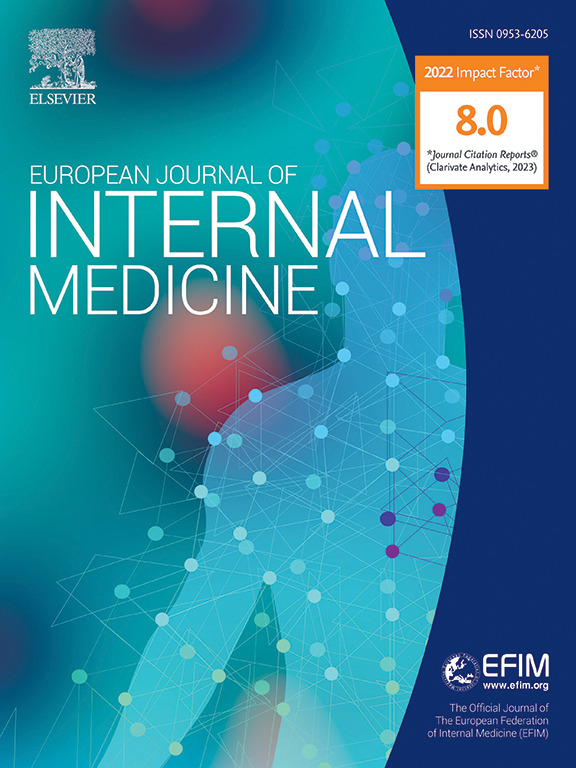大型类风湿性关节炎队列中对 2019 ESC/EAS 血脂异常管理指南的遵守情况:意大利风湿病学会 CORDIS 研究小组的数据。
IF 5.9
2区 医学
Q1 MEDICINE, GENERAL & INTERNAL
引用次数: 0
摘要
背景/目的:类风湿性关节炎(RA)患者的降脂治疗处方量较低,尽管接受了治疗,但往往达不到血脂阈值目标。然而,这些证据均来自小型、单一的队列。我们根据国际指南评估了RA队列中坚持降脂治疗以进行心血管(CV)一级预防的情况:我们对一个意大利 RA 队列进行了横断面分析。收集了疾病相关特征和传统的心血管风险因素。通过系统性冠状动脉风险评估 2(SCORE-2)算法估算了 10 年的冠状动脉风险。根据2019年欧洲心脏病学会/欧洲动脉粥样硬化学会指南评估了一级预防血脂异常策略:共纳入 1.133 名未发生过心血管事件的 RA 患者(78.2% 为女性,年龄为 60.6±10.2 岁)。根据SCORE-2,42.9%的患者为中度风险(1-5-%),33.3%为高度风险(5-10%),23.7%为非常高度风险(>10%)。在整个队列中,10%风险的患者中分别有12.9%在服用他汀类药物(P结论:在一个广泛的意大利 RA 队列中,50% 以上的患者有较高或极高的心血管疾病风险。在这些患者中,降脂治疗处方并不理想,导致无法实现低密度脂蛋白胆固醇目标。医生应改善血脂筛查和一级预防治疗,以降低心血管风险并改善 RA 患者的心血管并发症。本文章由计算机程序翻译,如有差异,请以英文原文为准。
Adherence to the 2019 ESC/EAS guidelines for dyslipidaemia management in a large rheumatoid arthritis cohort: Data from the CORDIS Study Group of the Italian Society of Rheumatology
Background/aim
Lipid-lowering therapy prescription is low in rheumatoid arthritis (RA) patients, often not achieving lipid threshold target despite treatment. However, evidence derives from small, monocentric cohorts. We assessed adherence to lipid-lowering treatment for primary cardiovascular (CV) prevention in a RA cohort according to international guidelines.
Methods
A cross-sectional analysis of an Italian RA cohort was performed. Disease-related features and traditional CV risk factors were collected. The 10-year CV risk was estimated by Systematic COronary Risk Evaluation 2 (SCORE-2) algorithm. The primary preventive dyslipidaemia strategy was assessed according to 2019 European Society of Cardiology/European Atherosclerosis Society guidelines.
Results
1.133 RA patients (78.2% female, aged 60.6±10.2 years) free from CV events were included. According to SCORE-2, 42.9% of patients were at moderate risk (1–5-%), 33.3% at high risk (5–10%) and 23.7% at very high risk (>10%). In the whole cohort, 12.9% of patients with <5%, 23.6% with 5–10% and 32.3% with >10% risk were on statin, respectively (p<0.001). According to 2019 ESC/EAS guidelines, 51.5% of patients had LDL-c at target. Among patients with LDL-c not at target, 76% were not on lipid-lowering treatment. At multivariate analysis, patients with higher CV risk had significantly lower probability of LDL-c at target.
Conclusion
In a wide Italian RA cohort, more than 50% of patients had high or very high CV risk. In these, lipid-lowering treatment prescription is suboptimal leading to not achievement of LDL-c target. Physicians should improve lipid screening and primary prevention therapy to reduce CV risk and improve CV comorbidity in RA patients.
求助全文
通过发布文献求助,成功后即可免费获取论文全文。
去求助
来源期刊
CiteScore
9.60
自引率
6.20%
发文量
364
审稿时长
20 days
期刊介绍:
The European Journal of Internal Medicine serves as the official journal of the European Federation of Internal Medicine and is the primary scientific reference for European academic and non-academic internists. It is dedicated to advancing science and practice in internal medicine across Europe. The journal publishes original articles, editorials, reviews, internal medicine flashcards, and other relevant information in the field. Both translational medicine and clinical studies are emphasized. EJIM aspires to be a leading platform for excellent clinical studies, with a focus on enhancing the quality of healthcare in European hospitals.

 求助内容:
求助内容: 应助结果提醒方式:
应助结果提醒方式:


